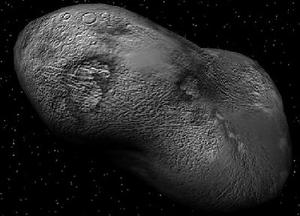Planetary securityRedirecting menacing asteroids
Sometime between 2029 and 2036, the asteroid Apophis will come uncomfortably close to Earth; if the asteroid, which weighs forty-six million tons, were to strike Earth, it would cause damage for thousands of miles around the epicenter; scientists propose ways to nudge the menacing asteroid off its current course

Asteroid Apophis, due for a near-earth visit in 2029 // Source: twoday.net
Shengping Gong and associates at Tsinghua University in Beijin have proposed an alternative method of deflecting the asteroid Apophis to make sure it does not strike the earth. They believe that rather than just blowing it up – this is what the European Space Agency has proposed in its Don Quijote project — a better approach would be to use a solar sail, as they describe in their paper in arXiv:1108.3183v1. The sail would slowly nudge the asteroid off its trajectory just enough to keep it from bothering us here on Earth. arXiv blog reports that Apophis is approximately 880 feet in diameter and weighs about forty-six million tons. Researchers say that if it struck Earth, it would cause damage for thousands of miles around the epicenter. It is not likely, though, to the destroy the entire planet.
Apophis was first discovered in 2004, and scientists say it will come uncomfortably close to Earth in 2029. The fear is that it would pass through what is known as a “keyhole” — a small gravitational zone near enough a planet to alter the course of an object — near Earth in 1936, and that the gravitational forces would pull it toward Earth and toward a collision with it.
The Chinese scientists propose using a space vehicle propelled by a solar sail that would move in a retrograde (opposite) orbit relative to Apophis fast enough so that when the collision between the space vehicle and the asteroid occurred, the vessel — moving at a speed of about 55-miles per second – the impact would be sufficient to push the menacing asteroid off its current path.
The major problem, the scientists admit, is aiming the space vehicle so that it actually hit the asteroid.
— Read more in Shengping Gong, Junfeng Li, and Xiangyuan Zeng, “Utilization of H-reversal Trajectory of Solar Sail for Asteroid Deflection,” arXiv:1108.3183v1 (16 August 2011)
